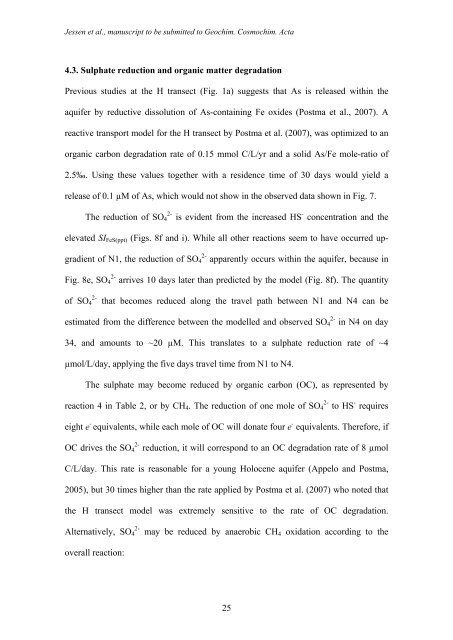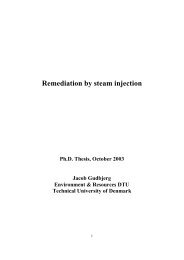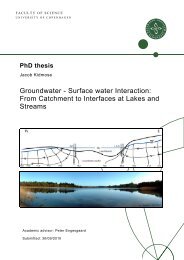Groundwater arsenic in the Red River delta, Vietnam ... - Fiva
Groundwater arsenic in the Red River delta, Vietnam ... - Fiva
Groundwater arsenic in the Red River delta, Vietnam ... - Fiva
You also want an ePaper? Increase the reach of your titles
YUMPU automatically turns print PDFs into web optimized ePapers that Google loves.
Jessen et al., manuscript to be submitted to Geochim. Cosmochim. Acta<br />
4.3. Sulphate reduction and organic matter degradation<br />
Previous studies at <strong>the</strong> H transect (Fig. 1a) suggests that As is released with<strong>in</strong> <strong>the</strong><br />
aquifer by reductive dissolution of As-conta<strong>in</strong><strong>in</strong>g Fe oxides (Postma et al., 2007). A<br />
reactive transport model for <strong>the</strong> H transect by Postma et al. (2007), was optimized to an<br />
organic carbon degradation rate of 0.15 mmol C/L/yr and a solid As/Fe mole-ratio of<br />
2.5‰. Us<strong>in</strong>g <strong>the</strong>se values toge<strong>the</strong>r with a residence time of 30 days would yield a<br />
release of 0.1 μM of As, which would not show <strong>in</strong> <strong>the</strong> observed data shown <strong>in</strong> Fig. 7.<br />
The reduction of SO4 2- is evident from <strong>the</strong> <strong>in</strong>creased HS - concentration and <strong>the</strong><br />
elevated SIFeS(ppt) (Figs. 8f and i). While all o<strong>the</strong>r reactions seem to have occurred up-<br />
gradient of N1, <strong>the</strong> reduction of SO4 2- apparently occurs with<strong>in</strong> <strong>the</strong> aquifer, because <strong>in</strong><br />
Fig. 8e, SO4 2- arrives 10 days later than predicted by <strong>the</strong> model (Fig. 8f). The quantity<br />
of SO4 2- that becomes reduced along <strong>the</strong> travel path between N1 and N4 can be<br />
estimated from <strong>the</strong> difference between <strong>the</strong> modelled and observed SO4 2- <strong>in</strong> N4 on day<br />
34, and amounts to ~20 μM. This translates to a sulphate reduction rate of ~4<br />
μmol/L/day, apply<strong>in</strong>g <strong>the</strong> five days travel time from N1 to N4.<br />
The sulphate may become reduced by organic carbon (OC), as represented by<br />
reaction 4 <strong>in</strong> Table 2, or by CH4. The reduction of one mole of SO4 2- to HS - requires<br />
eight e - equivalents, while each mole of OC will donate four e - equivalents. Therefore, if<br />
OC drives <strong>the</strong> SO4 2- reduction, it will correspond to an OC degradation rate of 8 μmol<br />
C/L/day. This rate is reasonable for a young Holocene aquifer (Appelo and Postma,<br />
2005), but 30 times higher than <strong>the</strong> rate applied by Postma et al. (2007) who noted that<br />
<strong>the</strong> H transect model was extremely sensitive to <strong>the</strong> rate of OC degradation.<br />
Alternatively, SO4 2- may be reduced by anaerobic CH4 oxidation accord<strong>in</strong>g to <strong>the</strong><br />
overall reaction:<br />
25





